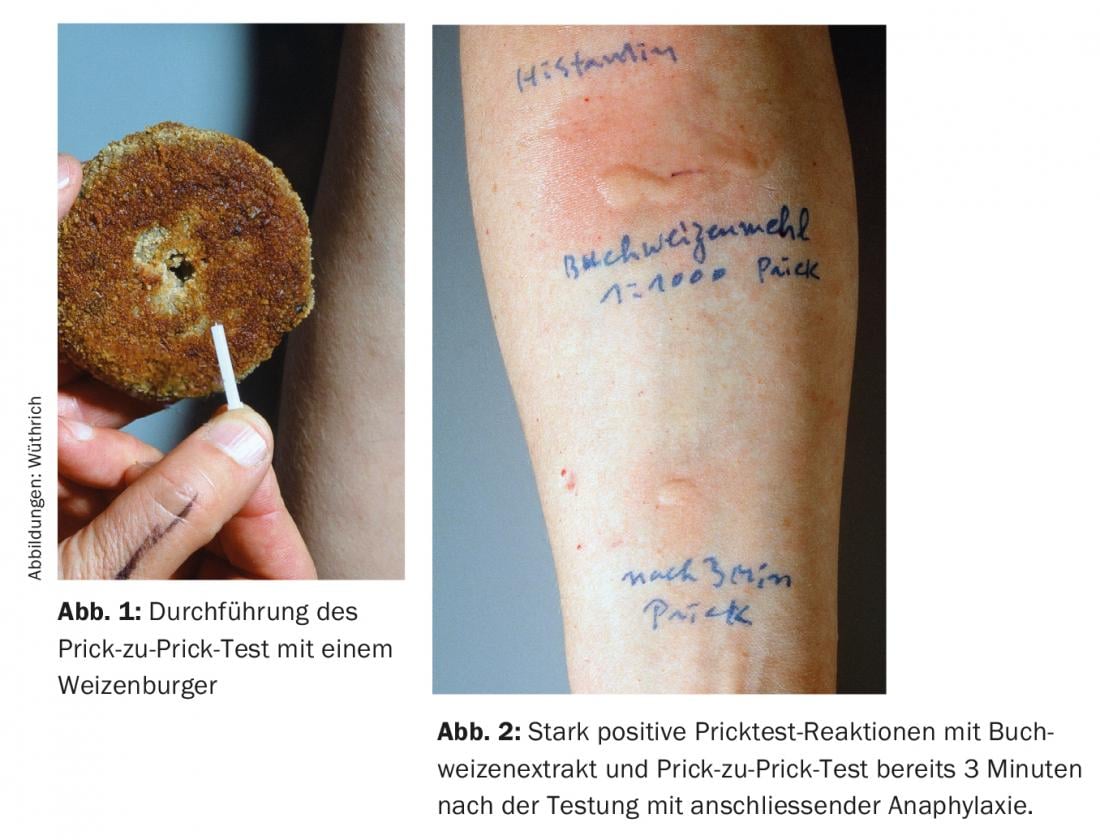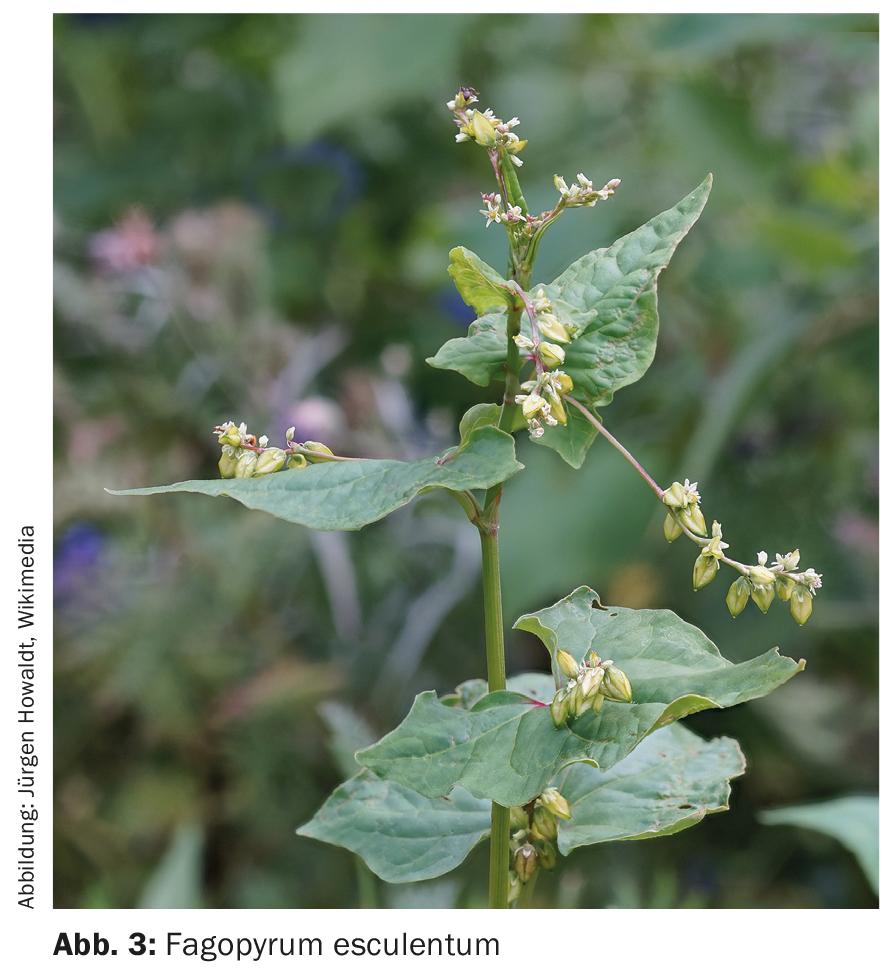In connection with buckwheat, an increased allergenic potential is discussed. Buckwheat is used, among others, in cases of gluten intolerance (celiac disease) and is an ingredient of “pizokel” and “polenta nostrana con grano saraceno”. In the meantime, quite a bit is known about molecular properties of this cereal and the associated allergenic risks.
Anamnesis: The 40-year-old druggist (Fr. Gabriele) ordered a vegetarian wheat burger at her beloved brasserie, which was currently offering Breton specialties on the menu (oysters, fruits de mer, various types of burgers and crepes, cider, etc.). After only three bites, she experienced a tingling sensation in her mouth, a feeling of heat in the head area, and swelling appeared on the palate, followed by generalized itching, urticarial wheals, and dyspnea, so that an emergency admission to the emergency ward of the Medical Clinic of the Winterthur Cantonal Hospital was made. There she was registered for allergological clarification at the allergy ward of the USZ.
Supplementary anamnesis
As the history revealed, the trained druggist had suffered from seasonal rhinoconjunctivitis since childhood, which weakened over the years and finally manifested itself only on a few days in the summer months. After completing her apprenticeship as a druggist, she initially continued to work in the same business, but rhinitis and conjunctivitis occurred in each case during the packaging of chamomile, celery and thyme spices, so that the patient gave up the job and accepted the management of a health food store. Here she noticed that she had an allergic reaction when taking a flower pollen preparation. After some time, respiratory complaints occurred when grinding buckwheat germ, so buckwheat was dispensed only in closed bags. She also experienced urticarial symptoms when eating foods containing buckwheat, which is why she strictly avoided specialties containing buckwheat flour.
Inquiry at the restaurant revealed that the wheat burger the patient had eaten (only three bites!) was fried in the same pan used to prepare a buckwheat crepe earlier. The patient had previously sought assurance from the landlady that the wheat burger did not contain buckwheat flour.
Allergological clarification
Routine prick testing revealed very strong to strong positive reactions to pollen from alder, hazel, birch, rye (grass plant family), mugwort, and sorrel. A blood sample was taken for specific IgE determination to buckwheat and sorrel, and the patient was asked to obtain a buckwheat burger and buckwheat flour from the brasserie.
In the prick-to-prick test with the buckwheat burger and a simultaneous prick test with buckwheat flour extract (preparation allergological-immunological laboratory of the Dermatological Clinic USZ, diluted 1:1000) the patient reacted with strong allergic wheals already after three minutes (Figs. 1 and 2) and general symptoms (redness, sensation of heat, dyspnea), which necessitated intravenous therapy with clemastine and a corticosteroid.

The RAST cap test result, which has since arrived, showed class 3 positivity (3.84 kU/L) for buckwheat and class 2 positivity (1.5 kU/L) for sorrel.
Diagnosis
- Wheat burger anaphylaxis in case of sensitization to (occult) buckwheat
- Status after inhalation allergy to buckwheat flour, chamomile, celery and thyme dust.
- Rhinoconjunctivitis pollinosa in polyvalent pollen sensitization, incl. on pollen of sorrel.
Comment
This case report of an anaphylactic reaction to buckwheat demonstrates once again that severe ingestive immediate reactions can occur in food sensitization even when only small amounts of occult allergens are present in the food [1–4].


Buckwheat – distribution and use
The genus buckwheat (Fagopyrum) does not belong to the cereal family, as the name might erroneously suggest, but to the knotweed family (Polygonaceae), like dock (Rumex L.) and rhubarb (Rumex L.). The true buckwheat (Fagopyrum esculentum) (Figs. 3 and 4) is therefore a pseudocereal. It is also (incorrectly) called Turkish wheat, suggesting that buckwheat arrived in Europe via Turkey; buckwheat is called “sarrasin” in French, “grano saraceno” in Italian. Buckwheat was planted in mountainous areas because of its short growing season of about five months and the possibility of obtaining a yield even from desolate sand and heath fields. Regional specialties are known which may contain buckwheat, e.g. “Pizokel” in Valtellina and Puschlav (Fig. 5) and “Polenta nostrana con grano saraceno” in Ticino (Fig. 6) . Due to the lack of gluten, pure buckwheat is unsuitable for baking bread on the one hand, but on the other hand it is suitable for feeding people with gluten intolerance or celiac disease. In drugstores and health food stores, buckwheat is sold as flour for pancakes, cakes and sauces, as a whole grain for risottos, groats and casseroles, as groats for grits, dumplings and soups, as flakes for cereals and desserts, etc. Also, the seeds serve as fodder for livestock and birds.


Allergic reactions to buckwheat
As an important food, buckwheat is found mainly in Asian countries, especially Japan. In the Far East, buckwheat litter is also used as a filling material for pillows. It is not surprising that several cases of ingestive and inhalant allergies were reported especially from Japan a very long time ago [5–7]. From Zurich we could describe six patients with allergic reactions to buckwheat in 1993 [8]. Case series with anaphylactic reactions from buckwheat have now been published from several European countries as well as from Asia and the USA [8–14].
Molecular characterization of buckwheat allergens.
For in vitro diagnostics, an IgE determination in the CAP test (Phadia, [15]) for Fagopyron esculantum (Fag e, f11) is available. According to information from Thermo Fisher Scientifics [15], approximately 30% of buckwheat proteins are 2S-albumins. These polypeptides have a molecular weight between 8 to 24 kDa and are water soluble.
The following allergens have been characterized so far:
- Fag e 1 is a 22-24 kDa protein, an 11S globulin, similar to legumin
- Fag e 10kD is an 8-17 kDa protein, a 2S albumin, a major allergen
- Fag e 16kD is a 16 kDa protein, a 2S albumin, pepsin-resistant
- Fag e 19kD is a 19 kDa vicilin-like protein, possibly a major allergen
- Fag e TI is a trypsin inhibitor
- Fag e 10kD is a major allergen of buckwheat and is detected in approximately 57% of buckwheat allergic individuals [16].
Possible cross reactions
Buckwheat seeds contain a thiamine-binding protein, with homology to the thiamine-binding proteins of rice and sesame seeds [17]. Cross-reactivity between buckwheat and rice has been demonstrated [18], also between buckwheat and latex [19], so cross-reactivity should be considered in the context of latex-fruit syndrome [20]. The 19 kDa buckwheat allergen has weak homology to the vicilin-like allergen of cashew (Ana o 1), English walnut (Jug r 2), and the 7S globulin of Sesamum indicum [21,22]. Cross-reactions of poppy seeds with buckwheat have also been described [23].
Conclusions
With the increasing use, especially in so-called whole food products and pastry specialties and in view of the cross-reactivities described above, an increase in severe anaphylactic reactions to buckwheat flour is to be expected. With the occasionally very high degree of sensitization, even traces can lead to massive reactions. Particularly affected are people who are professionally involved in the processing of buckwheat.
Literature:
- Trojan A, Wüthrich B: Anaphylactic reaction after consumption of a wheat burger contaminated by buckwheat in cases of high-grade sensitization to buckwheat. Allergology 1995; 18: 334-336.
- Wüthrich B, Trojan A: Wheatburger anaphylaxis due to hidden buckwheat. Clin Exp Allergy 1995; 25 (12): 1263. https://doi.org/10.1111/j.1365-2222.1995.tb03052.x
- Borelli S, Anliker M, Wüthrich B: Anaphylaxis to peanut: the problem of hidden allergens. Dtsch med Wschr 1999; 124: 1197-1200.
- Schäppi G, et al.: Hidden peanut allergens detected in various foods: findings and legal measures. Allergy 2001; 56(12): 1216-1222.
- Horesh AJ: Buckwheat allergy in children. Ann Allergy 1972; 30: 685-689.
- Nakamura S, Yamaguchi M: Studies on the buckwheat allergosis. Clinical investigation of 169 cases with the buckwheat allergosis gathered from the whole country of Japan. Allerg Immunol 1974/1975; 20/21: 457-465.
- Hong CS, Park HS, Oh SH: Dermatophagoides farinae, an important allergenic substance in buckwheat-husk pillows. Yonsei Med J 1987; 28(4): 274-281.
- Schumacher F, Schmid P, Wüthrich B: On pizocel allergy: a contribution on buckwheat allergy. Schweiz Med Wochenschr 1993; 123: 1559-1562.
- Schiffner R, et al: Anaphylaxis to buckwheat. Allergy 2001; 56(10): 1020-1021.
- Plaza T, Mahler V: Anaphylactic shock due to French galette. Type I allergic reaction to buckwheat. Dermatologist 2005; 56(2): 160-163.
- Stember RH: Buckwheat allergy. Allergy Asthma Proc 2006; 27: 393-395.
- Park K, Jeong K, Lee S: Clinical and laboratory findings of childhood buckwheat allergy in a single tertiary hospital. Korea J Pediatr 2016; 59: 402-407.
- Andersen JB, Kristensen B: Buckwheat allergy can cause live-threatening anaphylaxis. Ugeskr Laeger 2014; 176 pii: V08120509. [PubMed]
- Yanagida N, et al: Reactions of buckwheat-hypersensitive patients during oral food challenge are rare, but often anaphylactic. Int Arch Allergy Immunol 2017; 172(2): 116-122.
- Thermo Fisher Scientific: Allergy. www.phadia.com/en/Products/Allergy-testing-products/ImmunoCAP-Allergen-Information/Food-of-Plant-Origin/Grains/Buckwheat/, last accessed 07 Feb. 2019.
- Matsumoto R, et al: Molecular characterization of a 10-kDa buckwheat molecule reactive to allergic patients’ IgE. Acta allergologica 2004; 59(5):533-538.
- Watanabe K, et al: Characterization of thiamine-binding protein from buckwheat seeds. J Nutr Sci Vitaminol (Tokyo) 1998; 44(2): 323-328.
- Yamada K, et al: Cross-allergenicity between rice and buckwheat antigens and immediate hypersensitive reactions induced by buckwheat ingestion. [Japanese] Arerugi 1993; 42(10): 1600-1609.
- De Maat-Bleeker F, Stapel SO: Cross-reactivity between buckwheat and latex. Allergy 1998; 53: 538-539.
- Wüthrich B: Memoirs of an allergist: Happy New Year! – From the New Year’s aperitif to the emergency ward. Dermatology Practice 2017 Vol. 27, no. 6, pp. 37-41.
- Choi SY, et al: Characterization of buckwheat 19-kD allergen and Its application for diagnosing clinical reactivity. Int Arch Allergy Immunol 2007; 144: 267-274.
- Takumi K, et al: Immunochemical crossreactivity between globulins from buckwheat and indigo seeds. Biosci Biotechnol Biochem 1995; 59: 1971-1972.
- Oppel T, Thomas P, Wollenberg A: Cross-sensitization between poppy seed and buckwheat in a food-allergic patient with poppy seed anaphylaxis. Int Arch Allergy Immunol 2006; 14: 170-173.
DERMATOLOGIE PRAXIS 2019; 29(1): 4-6











